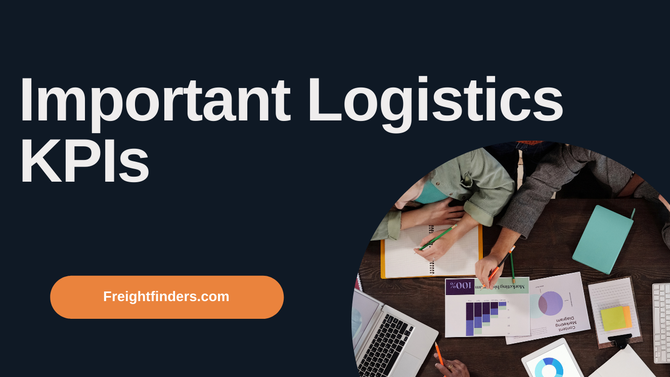As in most economic sectors, there are also KPI in logistics. But what are key performance indicators (KPIs) and what advantages do they bring? Which areas of the company can be optimised by analysing them?
You are looking for a cheap and fast transport? Use our freight search engine and choose a suitable partner out of our forwarding-network!
What Are Logistics Key Performance Indicators for?
The logistics KPI are also known as Key Performance Indicators. These indicators are used to measure performance, i.e. to monitor, analyse and optimise certain areas of operations. In logistics, processes are thus checked for their economic efficiency.
Logistics KPI Examples
Theoretically, every process can be analysed with logistics KPI. In general, the main areas can be divided into three categories.
- Purchase
- Transport
- Warehouse
In these sub-areas, various individual processes can be analysed for logistics performance indicators. As a rule, this allows you to optimise your company in terms of its profitability and thus save money and time. It is a matter of hitting exactly the right point between too little and too much. This balance can be achieved with simple formulas for the respective logistics KPIs. For the sub-areas already mentioned, we have given some examples for the most important and most frequently analysed logistics KPIs. There, you will also find the appropriate formulas.
Logistics KPI: Purchase
The logistics KPI for purchasing usually concern the purchase of new stock or also supplier negotiations. Examples would be the following.
Logistics KPI: Defect Rate
It is possible to calculate the percentage of failed orders that were fulfilled by the supplier due to either service or product quality. To do this, use the following formula:
Defect Rate = Defect Order / Total Orders Received x 100
Logistics KPI: Vendor-Compliance-Rate
Here, one learns how effectively the supplier works and with how much delay the purchased goods arrive in the warehouse. This logistics KPI allows you to check whether the price and delivery risks can be minimised and whether there is delivery security.
Vendor-Compliance-Rate = Orders Received Late / Total Orders Received x 100
Logistics KPI: Order Lead Time
The lead time indicator is one of the most important logistics KPI in purchasing. It is about how much time is needed for the entire process from ordering to transport, receipt and inspection of the goods.
Lead Time of Order = Date of Receipt of Order – Delivery Date
Logistics KPI: Transport
The logistics KPI for transport analyse the movement of goods within the supply chain and can improve these logistical processes. For example, transport costs, delivery and utilisation can be taken into account.
Logistics KPI: Transport Costs
An important logistics key performance indicator is whether the transport costs are bearable in relation to the turnover. Because only if the transport costs are comparably favourable is it worthwhile to continue using this supplier so that the turnover is high enough.
Ratio of Transport Costs to Turnover = Total Transport Costs / Turnover
Logistics KPI: On-Time Delivery
The calculation of how many deliveries arrive on time sounds banal but is extremely important. Here, it is often the last mile, i.e. the last part of the transport to the customer, that is paid attention to.
On-Time Delivery Rate = Number of Deliveries on Time / Total Number of Actual Deliveries x 100
Logistics KPI: Degree of Fleet Utilization
It is especially important for freight forwarders to know how much transport capacity an order requires compared to the total capacity. This logistics key performance indicator is calculated either in cubic metres (m3) or weight (kg).
Transport Utilisation = Used Capacity / Total Capacity
Logistics KPI: Warehouse
Other important logistics KPS can be found in the area of warehousing, especially if a company has warehouse locations. However, due to the outsourcing of these processes, this topic is also becoming more and more interesting for external service providers.
Logistics KPI: Warehousing Costs per Unit
Costs are always a fundamental factor in business. Therefore, storage costs naturally also play a role in logistics. The logistics KPI for storage costs analyses the relationship between storage costs and the number of products in the warehouse in a given period.
Warehousing Costs per Unit = Total Storage Costs / Nominal Capacity x Occupancy Rate
Logistics KPI: Utilization Ratio of Storage Space
This logistics performance indicator seems very simple, but it plays a fundamental role in warehousing. Because only when a warehouse is efficiently utilised is it also economical. As a rule, about up to 80% is used for storing products and the remaining 20% is used for aisles.
Storage Space Utilisation Rate = Area Occupied x 100 / Total Available Storage Space
Logistics KPI: Inventory Turnover Rate
The logistics turnover rate is one of the most important KPIs in logistics. Here, it is calculated how often the warehouse stock is turned over in a period of time. The inventory turnover rate is usually limited to the product level. A low logistics ratio for inventory turnover indicates overstocks and too high values are often an indication of high capital commitment.
Inventory Turnover Rate = Cost of Sales / Average Stock at Cost
Do you want to optimise you transports? With our Major Customer Portal, you will find the ideal partner for your shipments!
